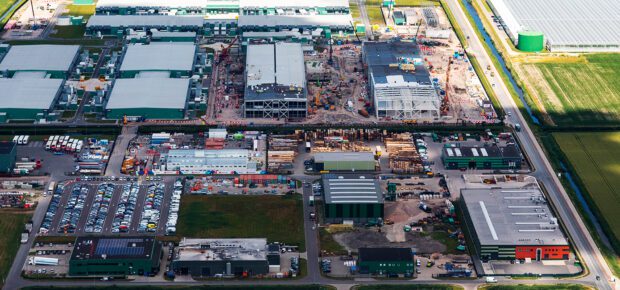March 12, 2024
A lot has been written about the way artificial intelligence is changing the way we live, work and learn. It may also change the physical landscape around us.
That’s because AI is set to spur the construction of new data centers, those large, warehouse-like facilities filled with servers that form the backbone of the internet.
The demand for AI and data center capacity is already apparent, with prices rising at existing data centers due to AI use. According to Data Bridge Market Research, the market for AI infrastructure is expected to hit $422 billion by 2029, growing at a compound annual rate of 44%.
“AI will stimulate additional data center use, expansion of current data centers and creation of new data centers,” said 2024 IEEE President Tom Coughlin.
What Are Data Centers?
A typical data center is about 100,000 square feet, which is a little bigger than an 81,000 square-foot soccer field, and a little smaller than two football fields, which total about 114,000 square feet. But the largest are more than 2 million square feet. Inside, they’re filled with rows and rows of servers. Companies lease computing time and data storage to run their IT operations, their e-commerce sites and more. Every time you choose a movie on your favorite streaming service, that movie streams from a data center.
The facilities can use large quantities of water to keep the servers cool, so they tend to have large structures on the roof to act as chillers.
Then there are the energy sources. A data center can consume 10 to 50 times more energy per square foot than a comparable office building.
That has placed intense focus on the source of power used by facilities and their carbon footprint. Solar and wind power are frequently used, which means that in addition to a large warehouse, renewable energy facilities tend to be built nearby.
In fact, the pace of data center construction, and the related energy demands, has driven construction of new solar farms nearby, creating solar energy hotspots in some regions.
Because of their large physical footprint, the energy demands and water consumption, data centers have drawn some opposition over concerns that they are not sustainable. Operators of these facilities are under intense pressure to increase their sustainability.
Where Are Data Centers Located?
Why are data centers built in some places and not others? The decision on where to build involves many factors.
The largest cluster of data centers in the world, located in Northern Virginia, has its roots in the 1990s, when several giants of the early internet located there and built fiber optic networks. Data centers arrived later because of the large availability of fiber optic cable.
Today, communications infrastructure is just one of many factors data center operators take into account when scouting new locations.
“Good high performance communication infrastructure is important as is relatively low power costs and reliability of those power sources,” Coughlin said. “Thus, weather and climate can be important factors. Operators look at major events and ask ‘Could this knock out power for a considerable period of time?’ Water for cooling is also important, as is availability of an IT workforce.”
How Much Energy Does AI Use?
AI processing is more intense than traditional computing because it relies on more data to make its outputs. As a result, it has higher energy requirements. The leading GPUs used for AI may consume as much as 700W of power, which is roughly equivalent to a microwave.
Coughlin notes that GPUs that consume twice as much energy may be available in the not too distant future. And because computing power generates heat, that will in turn drive greater use of liquid cooling to bring heat out of data centers.
Powering AI
The developers of the largest data centers, called hyperscalers, are acutely aware of the electricity needs of their facilities. Their reliance on wind and solar solves two challenges: it provides resiliency in the event of a local power outage.
“These organizations depend upon power,” Coughlin said. “Many of them have built their own solar power systems and even wind power systems. Some are planning modular nuclear power as part of their zero-carbon emission plans.”
In one recent trend, data centers have begun locating near other industrial facilities. That process takes advantage of waste water used in industrial processes for cooling. As a result, some data centers have wastewater treatment facilities on premises.
Learn more: Just how much energy does AI use? Recent research suggests that a single interaction on a generative AI model may consume as much energy as a light bulb. Check it out in IEEE Spectrum.





 Meaningful Momentum or Running in Place?
Meaningful Momentum or Running in Place? AI Through Our Ages
AI Through Our Ages Liquid Infrastructure: Our Planet's Most Precious Resource
Liquid Infrastructure: Our Planet's Most Precious Resource The Impact of Technology in 2025
The Impact of Technology in 2025 Quantum and AI: Safeguards or Threats to Cybersecurity?
Quantum and AI: Safeguards or Threats to Cybersecurity? Why AI Can't Live Without Us
Why AI Can't Live Without Us Bits, Bytes, Buildings and Bridges: Digital-Driven Infrastructure
Bits, Bytes, Buildings and Bridges: Digital-Driven Infrastructure Impact of Technology in 2024
Impact of Technology in 2024 Emerging AI Cybersecurity Challenges and Solutions
Emerging AI Cybersecurity Challenges and Solutions The Skies are Unlimited
The Skies are Unlimited Smart Cities 2030: How Tech is Reshaping Urbanscapes
Smart Cities 2030: How Tech is Reshaping Urbanscapes Impact of Technology 2023
Impact of Technology 2023 Cybersecurity for Life-Changing Innovations
Cybersecurity for Life-Changing Innovations Smarter Wearables Healthier Life
Smarter Wearables Healthier Life Infrastructure In Motion
Infrastructure In Motion The Impact of Tech in 2022 and Beyond
The Impact of Tech in 2022 and Beyond Cybersecurity, Technology and Protecting Our World
Cybersecurity, Technology and Protecting Our World How Technology Helps us Understand Our Health and Wellness
How Technology Helps us Understand Our Health and Wellness The Resilience of Humanity
The Resilience of Humanity Harnessing and Sustaining our Natural Resources
Harnessing and Sustaining our Natural Resources Creating Healthy Spaces Through Technology
Creating Healthy Spaces Through Technology Exceptional Infrastructure Challenges, Technology and Humanity
Exceptional Infrastructure Challenges, Technology and Humanity The Global Impact of IEEE's 802 Standards
The Global Impact of IEEE's 802 Standards Scenes of our Cyber Lives: The Security Threats and Technology Solutions Protecting Us
Scenes of our Cyber Lives: The Security Threats and Technology Solutions Protecting Us How Millennial Parents are Embracing Health and Wellness Technologies for Their Generation Alpha Kids
How Millennial Parents are Embracing Health and Wellness Technologies for Their Generation Alpha Kids Space Exploration, Technology and Our Lives
Space Exploration, Technology and Our Lives Global Innovation and the Environment
Global Innovation and the Environment How Technology, Privacy and Security are Changing Each Other (And Us)
How Technology, Privacy and Security are Changing Each Other (And Us) Find us in booth 31506, LVCC South Hall 3 and experience the Technology Moon Walk
Find us in booth 31506, LVCC South Hall 3 and experience the Technology Moon Walk Virtual and Mixed Reality
Virtual and Mixed Reality How Robots are Improving our Health
How Robots are Improving our Health IEEE Experts and the Robots They are Teaching
IEEE Experts and the Robots They are Teaching See how millennial parents around the world see AI impacting the lives of their tech-infused offspring
See how millennial parents around the world see AI impacting the lives of their tech-infused offspring Take the journey from farm to table and learn how IoT will help us reach the rising demand for food production
Take the journey from farm to table and learn how IoT will help us reach the rising demand for food production Watch technical experts discuss the latest cyber threats
Watch technical experts discuss the latest cyber threats Explore how researchers, teachers, explorers, healthcare and medical professionals use immersive technologies
Explore how researchers, teachers, explorers, healthcare and medical professionals use immersive technologies Follow the timeline to see how Generation AI will be impacted by technology
Follow the timeline to see how Generation AI will be impacted by technology Learn how your IoT data can be used by experiencing a day in a connected life
Learn how your IoT data can be used by experiencing a day in a connected life Listen to technical experts discuss the biggest security threats today
Listen to technical experts discuss the biggest security threats today See how tech has influenced and evolved with the Games
See how tech has influenced and evolved with the Games Enter our virtual home to explore the IoT (Internet of Things) technologies
Enter our virtual home to explore the IoT (Internet of Things) technologies Explore an interactive map showcasing exciting innovations in robotics
Explore an interactive map showcasing exciting innovations in robotics Interactively explore A.I. in recent Hollywood movies
Interactively explore A.I. in recent Hollywood movies Get immersed in technologies that will improve patients' lives
Get immersed in technologies that will improve patients' lives